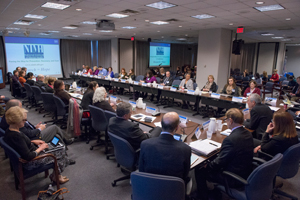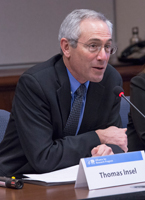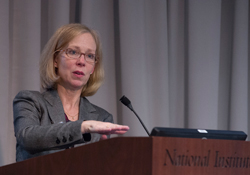Archived Content
The National Institute of Mental Health archives materials that are over 4 years old and no longer being updated. The content on this page is provided for historical reference purposes only and may not reflect current knowledge or information.
Alliance for Research Progress - February 7, 2014 Meeting
Alliance Report - February 2014
Date
Location
Overview

Progress Meeting
The National Institute of Mental Health (NIMH) convened the twentieth meeting of the Alliance for Research Progress (Alliance) on Friday, February 7, 2014 in Rockville, Maryland; this document provides an overview of the events. At Alliance meetings, participants hear about research advances, projects, and activities at the National Institutes of Health (NIH) and NIMH. The meetings also provide an opportunity for Alliance members to network with colleagues in person, and interact directly with NIMH director, Thomas Insel, M.D., and senior NIMH staff. Invitees include leaders from national mental health-related organizations representing patients and their families. The February meeting included presentations and discussion about psychotherapeutic standards, the new agenda for suicide prevention research, psychiatric genetics, discoveries in eating disorders, and the application of findings from the Recovery After an Initial Schizophrenia Episode (RAISE) program for early treatment of psychosis. For more information on the speakers, please see the attached agenda and participant list.
Major Themes
State of the NIMH – Mental Illness: The View from 2014
Thomas R. Insel, M.D., Director, NIMH
Dr. Insel called 2014 a pivotal year, due to advances promising real scientific traction and momentum. He pointed out that there has been phenomenal success in conquering medical illnesses; for example, deaths from heart disease are down 1.1 million, and AIDS is no longer always fatal. With 30,000 fewer deaths, AIDS has been redefined as a chronic disease. However, this phenomenal progress has not been repeated for mental illnesses, despite multiple efforts. As many as 38,000 Americans die by suicide per year. Dr. Insel said, “It's not only mortality that we worry about here, but there have been two reports that are really very significant over the last few months about morbidity and the disability.” From recent global efforts to understand diseases, injuries, and risk factors, we have learned that brain disorders are now the leading category of disease burden in the US, and growing in the world. Furthermore, Dr. Insel mentioned that mental disorders are chronic and disabling for young people.

Thomas Insel, M.D.
Dr. Insel discussed the breakthroughs of the year as determined by Science. NIMH funded 4 out of the 10 selected for 2013, including: (1) precision gene editing through light programming; (2) a revolutionary way to see the brain’s structure and molecules by plasticizing and staining; (3) sleep as the driver of metabolite clearance from the brain; and, (4) cerebral organoids to model human brain development. Dr. Insel talked about the Davos World Economic Forum he recently attended; with 20 different sessions on health, most focused on mental health. Attendees recognized mental health as a global problem with enormous economic consequences that is also heavily stigmatized and in need of global solutions. Here at home, the White House and Congress have taken an interest in the need to overhaul how we address mental health. For example, the President has described the Brain Research through Advancing Innovative Neurotechnologies (BRAIN) Initiative as the “Next Great American Project,” like the moon shot during the Kennedy Administration. BRAIN is designed to create the tools needed for a dynamic picture of the brain in action.
Dr. Insel briefly touched on other NIMH efforts, including updating the Strategic Plan, with emphases on: (1) the Research Domain Criteria (RDoC) project; (2) new approaches for clinical trials that define targets to understand disorders; (3) the Early Predication and Prevention of Psychosis initiative; (4) expanding the RAISE program for treating a first episode of psychosis to improve outcomes; and, (5) determining where we have the most traction to reduce health disparities. He noted that investments in science are flat; having lost 25-35% of NIMH’s purchasing power, the ability to capitalize on advancements from research has been greatly reduced. He described how his brief role as acting director of the National Center for Advancing Translational Sciences (NCATS) taught him that a shift towards engaging citizen scientists and private funders is needed, especially in austere times. Group efforts toward registries, team science, and clinical trials will create the data and information pathways to accomplish what needs to be done.
As a fresh example, Dr. Insel called on Andrew Nierenberg, M.D., Director, Bipolar Clinic and Research Program, Massachusetts General Hospital to talk about a citizen science project, the national Patient-Centered Clinical Research Network (PCORNet). The Patient-Centered Outcomes Research Institute (PCORI) was authorized by Congress, and funded under the Affordable Care Act (ACA), to conduct research to provide information to make more informed healthcare decisions. PCORNet will create an infrastructure for large registries in a patient-powered research network across medicine. Dr. Nierenberg said participants are not patients or subjects, but collaborators in a “Learning Healthcare System.” One of the PCORNet efforts focuses on mood and intends to enroll 50,000 people who will donate their medical records and biomarkers. Dr. Nierenberg invited the groups around the table to participate. Dr. Insel invited Dr. Nierenberg to provide a detailed overview of the project at an upcoming meeting of the Alliance.
Psychotherapeutic Standards
Philip Wang, M.D., Dr.PH, Deputy Director, NIMH

Philip Wang, M.D., Dr.PH
With regard to the ACA and the Parity Law, Dr. Wang told Alliance members that “…psychotherapy standards are really going to be necessary for separating what really does work and should be paid for from what is completely unproven and has no evidence of efficacy or safety.” He noted that with the new understanding that mental disorders are neural circuit disorders comes new ways of creating and applying treatments, such as direct brain stimulation, brain surgery, electroceuticals, video game training, cognitive training for schizophrenia, and attention bias modification in eating disorders. The law requires treatments to meet “evidenced-based standards,” which are not clear. There are strict standards for drugs; however, regulators see processes that are highly variable and not transparent for assessing efficacy of psychotherapeutics. To address this issue, the Institute of Medicine will conduct a study for the purpose of improving regulation of psychotherapeutics. The study will begin in March with a goal of a report in September. Many stakeholders will be involved, including some Alliance members. During the discussion period, Alliance members shared their views on the critical importance of having standards for non-quantitative treatments, and a process for incentivizing development of new therapies for fast approval.
Significance of the New Prioritized Agenda for Suicide Prevention Research
Phillip Satow, M.A., Co-founder and Chairman, The JED Foundation

Mr. Satow and Dr. Insel, co-chairs of the Action Alliance for Suicide Prevention’s Research Prioritization Task Force, recently completed a three-year effort to prepare and release the Prioritized Research Agenda for Suicide Prevention: An Action Plan to Save Lives (Research Agenda). Mr. Satow told Alliance members that more than 60 national and international research experts and over 700 individuals representing stakeholders identified priorities for the Research Agenda. He stated that overall rates of suicide have not decreased in 50 years, and that suicide mortality in populations with mental disorders is about three times greater than in the general population. The Research Agenda, if fully implemented, has the potential to reduce attempts and deaths by 20% in five years and 40% or more in 10 years, and to galvanize the suicide prevention field. Mr. Satow encouraged Alliance members to widely disseminate the document. With regard to public health impact, Mr. Satow illustrated how the hypothetical effect of shut-off devices in cars linked to carbon monoxide sensors, a technology that could be inexpensive per vehicle and is currently feasible, could prevent most suicides from carbon monoxide poisoning in automobiles. Mr. Satow thanked NIMH’s Jane Pearson, Ph.D. and other staff for their work in developing the Research Agenda.
Psychiatric Genetics: Thinking Outside the Box
Jordan Smoller, M.D., Sc.D., Director, Psychiatric and Neurodevelopmental Genetics Unit, Massachusetts General Hospital; Professor of Psychiatry, Harvard Medical School

Dr. Smoller told the Alliance that genetic researchers ask: Is a disorder familial, how do genes contribute, what genes are involved, and how do they cause disease? While mental disorders have high familial risk and heritability, before 2008 virtually no specific genetic risk factors had been identified. Now, over 150 have been found, and they are not the usual suspects. Dr. Smoller described the purpose of genome-wide association studies (GWAS) conducted by the Psychiatric GWAS Consortium (http://pgc.unc.edu), which is to conduct meta-analyses of genome-wide data for psychiatric disease. To date, the PGC has conducted large-scale genetic analyses for autism spectrum disorder, attention deficit hyperactivity disorder, depression, bipolar disorder, and schizophrenia, and is expanding to include other disorders. A combined analysis of all five disorders identified shared genetic influences across the disorders. Genome-wide analyses have led to the discovery of common and rare genetic risk factors. Results of these analyses have begun to point to biological pathways that contribute to illness. Considering that current drugs are based on biological insights that are more than 40 years old, genetic findings are suggesting novel pathways that may point to more effective treatments. Dr. Smoller stated that we are also beginning to see the effects of genes on brain architecture as shown in brain imaging. What is clear is that these findings do not map on to DSM categories. However, these discoveries may lead to a better understanding of disease biology, new treatment targets, insights into comorbidities, and prospects for disorder classification.
Dr. Smoller mentioned that a study of psychiatrists’ attitudes and abilities to discuss genetic finding with patients found that while a quarter of psychiatrists felt competent to discuss these topics with families and patients, only 15% said their training had prepared them to do so, though 83% of participants indicated thoughts that it is their duty to discuss genetic information. Dr. Smoller said that clinicians need to be educated, because family history does matter; it is still the best predictor. He mentioned that one mechanism to bridge the gap between the identification of genetic risk signals and developing the next generation of mediations may be NIH’s recently launched partnership involving 10 biopharmaceutical companies and several nonprofit organizations: the “Accelerating Medicines Partnership” (AMP ). The AMP aims to distinguish biological targets of disease most likely to respond to new therapies and characterize biomarkers. Alliance members wanted to know how big the database should be and how it could be used to increase diversity. In response, Dr. Smoller said “…the larger the study, the more discoveries would be made. Will we be able to use this information to guide drug therapy? Unfortunately, the studies are not compelling so far. With larger studies, genetics can reveal side effects or obvious benefits. Right now anything that looks moderately helpful could be clinically useful, since it is so hard to find the perfect treatment.” Dr. Insel said that a major challenge remains translating genetic associations, each of which increases the risk of illness only a small amount, into a target for treatment development. Additional research is needed in this area to spur the development of new and effective treatments.
Advances in Eating Disorder Research
Cynthia Bulik, Ph.D., F.A.E.D., Distinguished Professor of Eating Disorders Department of Psychiatry, School of Medicine; Professor of Nutrition, Gillings School of Global Public Health; Director, University of North Carolina Center of Excellence for Eating Disorders; Co-Director, UNC Center for Psychiatric Genomics

Dr. Bulik took the Alliance on a tour of changes to the diagnostic criteria for eating disorders (ED) in the Fifth Edition of the Diagnostic and Statistical Manual of Mental Disorders (DSM-5) and shattered nine myths about ED. In the first myth, she said that it is not true that you can tell by looking at someone if they have an ED. The reality is that affected people come in all sizes. The second and third myths are that families or mothers are to blame. Myth #4 is that ED is a choice: EDs are illnesses, not choices. Myth #5 is that EDs are the province of White upper-middle-class teenage girls. Dr. Bulik noted that fourteen million people have ED, cutting across all lines and ages and including every racial and ethnic group, men and women, and sexual orientation. ED does not discriminate. Myth #6 is that EDs are trivial or benign. Dr. Bulik mentioned that there is a high suicide risk in all ED. Many believe myth #7—that the media alone are to blame for ED. However, research has shown that EDs run in families, are heritable, and that genes play a substantial role along with environment. Her group is undertaking the largest GWAS ever in ED through the Anorexia Nervosa Genetics Initiative (http://www.med.unc.edu/psych/eatingdisorders/our-research/angi), but need at least 25,000 people to participate. Myth #8 tells us genes are destiny, but heritability varies due to environment, gene-environment interactions, and epigenetic influences. She encouraged participants to embrace complexity and realize that there are genetic risk factors, genetic protective factors, environmental risk factors, and environmental protective factors that influence risk for ED. While the ninth myth says EDs are for life, Dr. Bulik reminded everyone that the disorders are treatable and that there is a need to understand the neurobiology of ED. From a public health standpoint, Dr. Bulik mentioned that in our efforts to address obesity, we do not want to focus on dieting, but rather emphasize increased availability and affordability of food for healthy eating and physical activity. She encouraged Alliance members to share correct information about ED and join in busting these prevalent myths.
Implementing Community Based Initiatives for Early Treatment of Psychosis: Life After the RAISE Connection Program
Lisa Dixon, M.D., M.P.H., Professor of Psychiatry, Columbia University Medical Center; Director, Center for Practice Innovations, Division of Mental Health Services and Policy Research, New York State Psychiatric Institute

Dr. Dixon opened with an acknowledgement of Wayne Fenton and how the opportunities afforded by the RAISE study reflect Dr. Fenton’s commitment to improve the lives of individuals diagnosed with schizophrenia. She presented the rationale for early treatment, underscoring the promise of reducing the duration of untreated psychosis and supplying evidence-based early intervention services in reducing long term disability. She then reviewed how the experience of implementing the RAISE Connection program for first episode psychosis (FEP) in New York and Maryland led to continuation of these programs in both states. New York’s new program is called OnTrackNY and Maryland’s program is called the Early Intervention Program. RAISE Connection services include psychiatric treatment, employment and educational support, substance use disorder treatment, suicide prevention, and family education and support, for individuals and their families. Individuals receive care from a specialized team for up to two years, based on clients’ needs and preferences. The focus is on disability, functioning, recovery and shared decision-making. The initial RAISE Connection study demonstrated that programs were feasible, could effectively recruit and retain individuals in care, and were able to achieve outcomes of enhancing rates of school and work participation as well as symptomatic remission. Dr. Dixon noted that the person-centered approach to family involvement ensured nearly 100% of family participation. During her presentation, Dr. Dixon shared a video in which a patient describes the progress he has made toward fulfilling his dream (“Fulfilling My Dream” video and others).

The Alliance wanted to know about the model for reaching providers for earlier access to people with FEP, but Dr. Dixon noted that “even with huge outreach efforts, it isn’t cost effective for the payoff. Direct outreach to patients and families is more productive.” A member asked if the model could be applied to other disorders. Dr. Dixon said that scientists have to develop accurate early assessments, but she felt confident that this model can be adapted. Dr. Insel said that diagnostic labels could get in the way of helping people get better outcomes. The timeframe between 14-22 years of age is stormy for many young people, and better diagnostics are needed to provide effective help.
View additional images from the 2014 Alliance for Research Progress Winter Meeting on the NIMH Flickr photo stream at https://www.flickr.com/photos/nimhgov/sets/72157644134873398/
Additional Event Information
Alliance for Research Progress - February 7, 2014 Meeting
Alliance for Research Progress - February 7, 2014 Meeting >> Agenda
Alliance for Research Progress - February 7, 2014 Meeting >> Participant List
